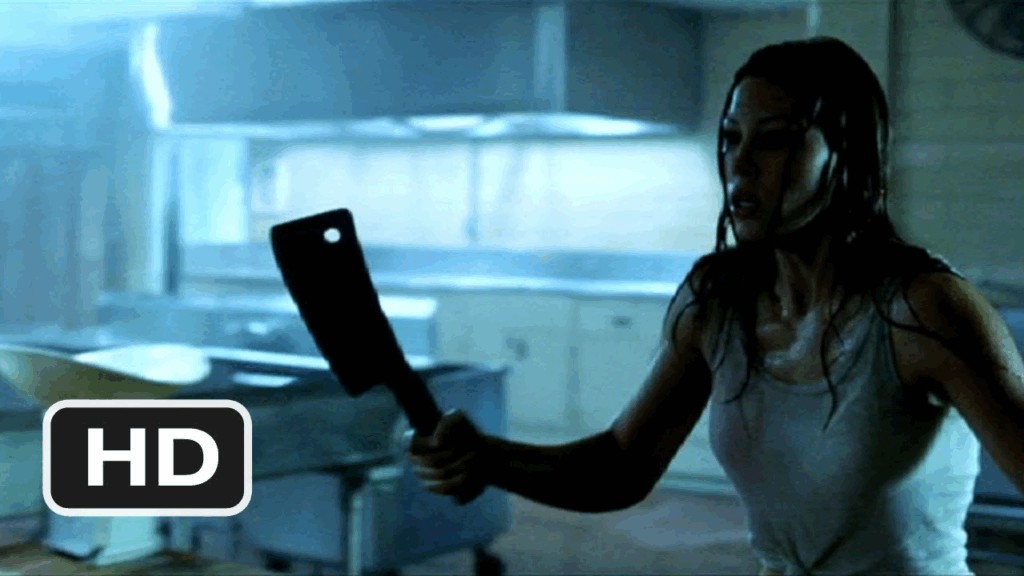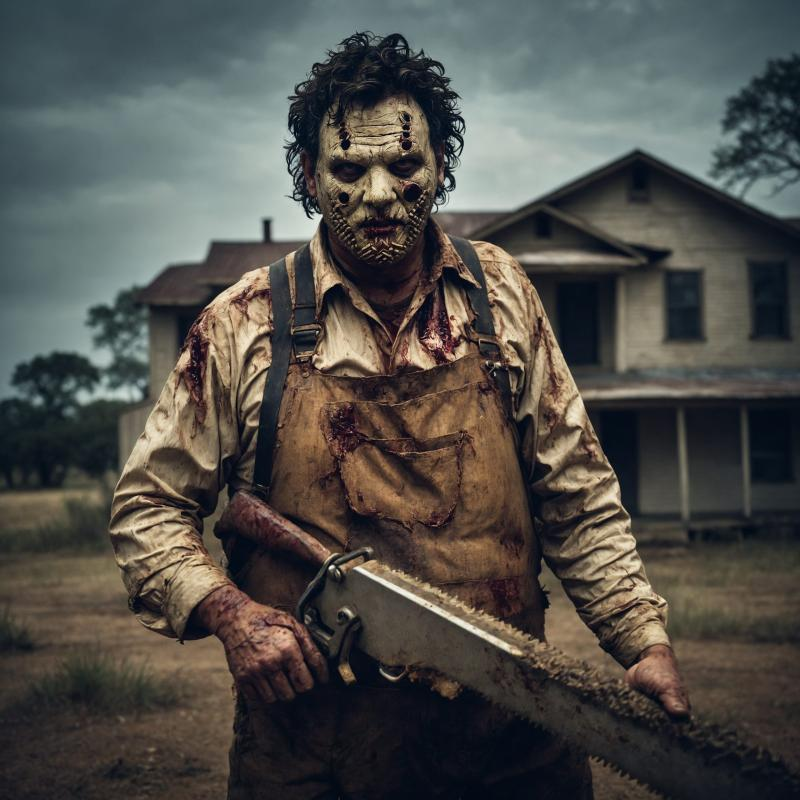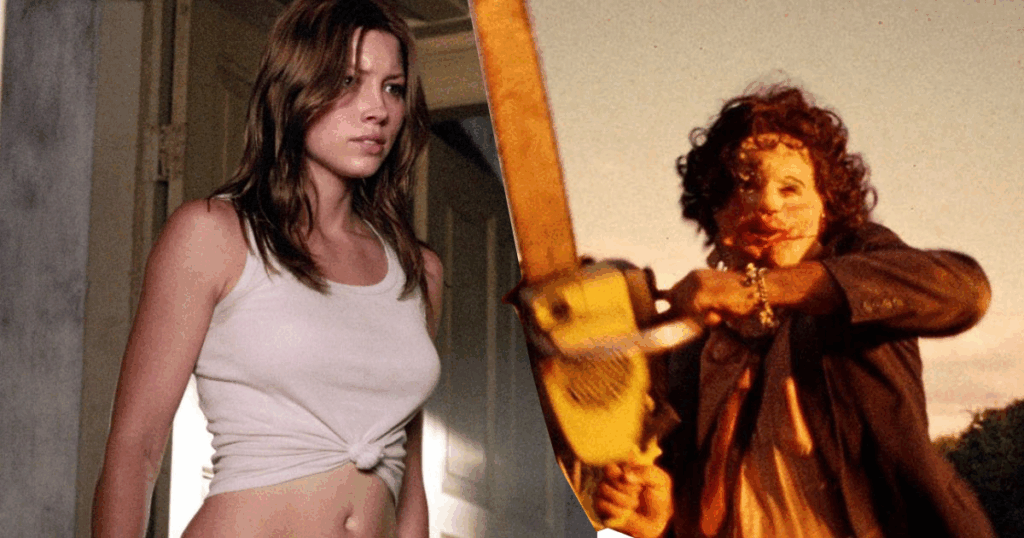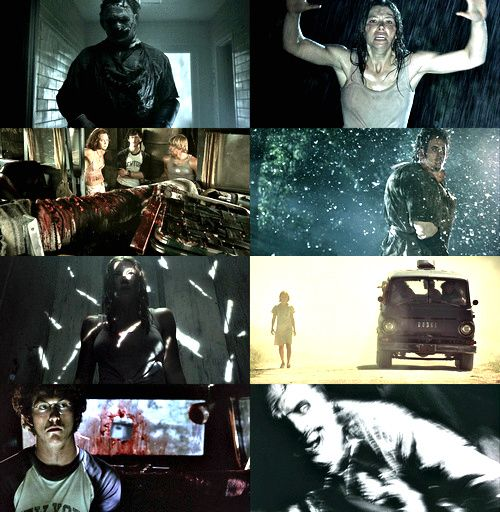The Texas Chainsaw Massacre (2003).

Introducing The Texas Chainsaw Massacre (2003): A Brutal Reimagining of a Horror Classic
Overview
Released on October 17, 2003, The Texas Chainsaw Massacre is a visceral remake of Tobe Hooper’s 1974 horror masterpiece, reintroducing the iconic Leatherface to a new generation. Directed by Marcus Nispel and produced by Michael Bay’s Platinum Dunes, this film reinvents the original’s raw terror with polished production values, intense gore, and a modern cinematic sensibility. Starring Jessica Biel, Jonathan Tucker, Erica Leerhsen, Mike Vogel, and Eric Balfour, the film follows a group of friends who encounter a deranged family of cannibals in rural Texas. With a runtime of 98 minutes, it blends relentless horror with psychological tension, earning its place as a standout remake in the early 2000s horror revival. This article provides a comprehensive exploration of the film’s plot, cast, production, themes, reception, and lasting impact.

Plot Summary
Set in August 1973, The Texas Chainsaw Massacre (2003) follows five young friends—Erin (Jessica Biel), Kemper (Eric Balfour), Morgan (Jonathan Tucker), Andy (Mike Vogel), and Pepper (Erica Leerhsen)—traveling through Texas in a van after a music festival in Mexico. Their road trip takes a dark turn when they pick up a traumatized hitchhiker (Lauren German), who rants about a “bad man” before shockingly committing suicide in their van. Shaken, the group seeks help in the small town of Fuller, Texas, but their decision leads them into the clutches of the Hewitt family, a clan of sadistic cannibals.
The Hewitts, led by the hulking, chainsaw-wielding Leatherface (Andrew Bryniarski), include the sinister Sheriff Hoyt (R. Lee Ermey), the manipulative Luda Mae (Marietta Marich), and other deranged relatives. As the friends are hunted one by one, Erin emerges as the resilient “final girl,” fighting to survive Leatherface’s brutal attacks and uncover the family’s horrific secrets, including their penchant for cannibalism and the origins of Leatherface’s grotesque mask. The film builds to a harrowing climax, with Erin navigating a nightmarish slaughterhouse and confronting the full extent of the Hewitt family’s depravity.
Unlike the 1974 original, which relied on psychological horror and implied violence, the 2003 remake amplifies the gore and physical brutality, delivering graphic kills and intense chase sequences. The film also introduces a pseudo-documentary framing device, with grainy “found footage” and a narrator (John Larroquette, reprising his role from the original) claiming the events are based on true events, adding a layer of chilling realism.

Cast and Characters
- Jessica Biel as Erin: Biel’s breakout role as the resourceful and determined final girl anchors the film. Her performance blends vulnerability with fierce survival instincts, making Erin a memorable heroine.
- Jonathan Tucker as Morgan: The group’s intellectual, whose wit and bravery are tested by the Hewitts’ cruelty.
- Erica Leerhsen as Pepper: A free-spirited character whose brief romance with Andy adds emotional stakes.
- Mike Vogel as Andy: The group’s athletic member, whose loyalty leads to tragic consequences.
- Eric Balfour as Kemper: Erin’s boyfriend, whose impulsive decisions set the group’s fate in motion.
- Andrew Bryniarski as Leatherface: Bryniarski’s imposing physicality and silent menace make Leatherface a terrifying presence, updating the character with a more muscular, brutal edge.
- R. Lee Ermey as Sheriff Hoyt: Ermey steals scenes as the sadistic, corrupt sheriff, bringing intensity and dark humor to the role.
- Supporting Cast: Includes Lauren German as the hitchhiker, Marietta Marich as Luda Mae, and Heather Kafka as Henrietta, among others.
Production and Development

The 2003 remake was a product of Platinum Dunes, a production company founded by Michael Bay, Brad Fuller, and Andrew Form to revitalize classic horror films. After the success of The Blair Witch Project and other early 2000s horror hits, the team saw potential in reimagining The Texas Chainsaw Massacre for a modern audience. Marcus Nispel, a music video director making his feature film debut, was chosen for his visual flair, while screenwriter Scott Kosar crafted a script that honored the original’s spirit while introducing new elements, such as the Hewitt family and a more explicit backstory for Leatherface.
Filming took place in Austin, Texas, during the summer of 2002, with a budget of $9.5 million. The production leaned heavily on practical effects, with makeup artist Scott Patton designing Leatherface’s grotesque human-skin mask. The iconic slaughterhouse scenes were shot in a real, abandoned meatpacking plant, adding authenticity to the film’s oppressive atmosphere. Cinematographer Daniel Pearl, who worked on the 1974 original, returned to lens the remake, using a muted color palette and gritty textures to evoke dread. The score by Steve Jablonsky, combined with sound design emphasizing chainsaw roars, heightened the film’s intensity.
The production faced challenges, including the intense Texas heat and the physical demands on the cast, particularly during chase sequences. Jessica Biel reportedly performed many of her own stunts, adding realism to Erin’s desperate fight for survival. The film’s graphic violence sparked debates about its R rating, but it avoided an NC-17 cut by carefully balancing gore with psychological horror.

Themes and Style
The Texas Chainsaw Massacre (2003) explores themes of isolation, societal decay, and the primal fear of being hunted. The rural Texas setting, with its abandoned towns and decaying houses, serves as a metaphor for forgotten communities and unchecked evil. Unlike the original, which critiqued consumerism and the Vietnam War era, the remake focuses on raw survival and the horror of encountering a family unbound by morality. Leatherface and the Hewitts embody a perverse distortion of family values, with Sheriff Hoyt’s authoritarian cruelty and Luda Mae’s warped maternal instincts adding psychological depth to their villainy.
Stylistically, the film blends gritty realism with polished horror aesthetics. Nispel’s music video background is evident in the sleek camerawork and kinetic pacing, while Pearl’s cinematography contrasts the sun-scorched Texas landscape with claustrophobic interiors. The remake amplifies the original’s visceral impact with graphic violence, including dismemberment and impalement, but retains moments of restraint, letting tension build through sound design and Leatherface’s silent menace. The pseudo-documentary framing and “true story” claim, while fictional, tap into early 2000s trends of found-footage horror, adding a layer of unease.

Reception and Box Office
Upon release, The Texas Chainsaw Massacre (2003) received mixed reviews but was a commercial triumph. Critics praised its intense atmosphere, Biel’s star-making performance, and Ermey’s chilling portrayal of Sheriff Hoyt, though some felt it lacked the original’s raw, subversive edge. Roger Ebert gave it two stars, calling it “effective but not as unsettling as the original,” while Variety lauded its “unrelenting terror and slick production values.” It holds a 37% rating on Rotten Tomatoes, reflecting its divisive critical response, but audiences gave it a B CinemaScore, indicating strong fan approval.
The film grossed $107 million worldwide against its $9.5 million budget, opening at #1 in the U.S. with $28 million. Its success sparked a wave of horror remakes in the 2000s, including The Amityville Horror (2005) and Friday the 13th (2009), cementing Platinum Dunes’ influence. The film also spawned a prequel, The Texas Chainsaw Massacre: The Beginning (2006), exploring the Hewitt family’s origins.

Cultural Impact and Legacy
The Texas Chainsaw Massacre (2003) played a pivotal role in the early 2000s horror remake boom, proving that classic horror properties could be modernized for new audiences. Its slick production and intense scares appealed to a generation raised on slasher films, while its graphic violence pushed boundaries, influencing the “torture porn” subgenre popularized by Saw and Hostel. Jessica Biel’s performance launched her into stardom, and R. Lee Ermey’s Sheriff Hoyt became a fan-favorite villain, quoted for lines like “You ain’t goin’ nowhere.”
The film’s depiction of Leatherface as a tragic, disfigured figure added depth to the character, inspiring debates about his motivations and the Hewitt family’s psychology. Its exploration of rural decay and familial horror resonated with audiences, reflecting anxieties about isolated communities and unchecked violence. The remake remains a touchstone for horror fans, often cited in discussions of successful remakes alongside Dawn of the Dead (2004).

Availability and Special Features
The Texas Chainsaw Massacre (2003) is available on streaming platforms like Peacock, Amazon Prime, and Shudder, as well as on Blu-ray and DVD. The Blu-ray release includes a director’s commentary by Marcus Nispel, deleted scenes, and a documentary, Chainsaw Redux: Making a Massacre, detailing the film’s production. Alternate endings and behind-the-scenes featurettes highlight the practical effects and stunt work, offering insight into the film’s creation.
Controversies
The film’s graphic violence and perceived exploitation of the “true story” angle sparked controversy. Some critics argued it glorified gore, while others defended its intensity as true to the horror genre. The depiction of the Hewitt family and rural Texas drew criticism for stereotyping Southern communities, though defenders noted the film’s fictional nature. The remake’s divergence from the original’s minimalist horror also alienated some purists, who felt it prioritized shock value over atmosphere.
Conclusion
The Texas Chainsaw Massacre (2003) is a bold, brutal reimagining that honors its predecessor while carving its own path. With its stellar cast, relentless pacing, and chilling atmosphere, it captures the primal terror of Tobe Hooper’s original while embracing the polished horror aesthetics of the 2000s. Jessica Biel’s Erin and R. Lee Ermey’s Sheriff Hoyt stand out as iconic performances, while Leatherface remains a towering figure in horror history. Despite mixed reviews, its commercial success and cultural impact solidify its status as a modern horror classic, continuing to terrify and captivate audiences over two decades later.
